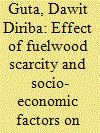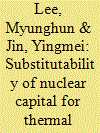| Srl | Item |
| 1 |
ID:
119150


|
|
|
|
|
| Publication |
2013.
|
| Summary/Abstract |
This paper discusses China's relatively new structure of dual onshore and offshore RMB markets. Its distinguishing feature is both offshore trading at exchange rates that are market determined and onshore trading at exchange rates anchored at the official spot rate with capital account inconvertibility. We note that thus far the CNH and CNY spot rates have largely tracked each other, suggesting that the shadow price on the convertibility constraint onshore and also the offshore diversification benefit is close to zero. However, this could change in the future. We discuss the potential for the offshore RMB market to grow with trade settlement and bilateral swap arrangements in RMB, which would provide a big enough pool of liquidity for the RMB to become a vehicle currency and reserve currency. These potential developments will be restrained by onshore inconvertibility, but moving to convertibility seemingly implies major change in China's financial structure and the offshore RMB arrangements are only a small first step along this path. Crucial in this evolution of arrangements will be future Chinese growth performance and the relative attractiveness of onshore inconvertible but offshore marketable RMB relative to the debt laden and slow growth currencies of the USA, the EU and Japan.
|
|
|
|
|
|
|
|
|
|
|
|
|
|
|
|
| 2 |
ID:
136232


|
|
|
|
|
| Summary/Abstract |
In Ethiopia biomass is predominantly utilized for household energy needs often using inefficient rudimentary stoves which cause adverse environmental and welfare effects. This paper examined the contribution of biomass resources to rural household energy use and energy substitution. The analysis applied the ordinary least square in the final stage estimation of fuelwood and overall biomass energy consumption by using predicted shadow prices. The paper used Tobit model to estimate charcoal and agricultural fuel consumption due to the presence of censoring. An increase in fuelwood shadow price was associated with reduced household fuelwood consumption with price elasticity of −0.38. The cross price elasticity between fuelwood and agricultural fuels revealed no evidence of energy substitution, which conforms to the findings of previous studies. Household access to electricity was associated with lower household biomass energy utilization but kerosene was not fuelwood substitute. Household energy use conformed to the ‘fuel stacking’ or ‘multiple fuel use’ concept, but households preferred modern energy options as welfare increased in areas where modern energy is available. This suggests that there is a promising prospect for fuel-transition, but access to modern energy and economic growth have key roles. The findings suggest that a concerted policy effort is required that would help diversify rural livelihoods, improve living standards and encourage economic growth, encourage inter-fuel substitution through improved modern energy access and afforestation to increase biomass supply.
|
|
|
|
|
|
|
|
|
|
|
|
|
|
|
|
| 3 |
ID:
143405


|
|
|
|
|
| Summary/Abstract |
Since the end of the 20th century, numerous studies have analyzed Chinese economic development to gauge whether China's rapid growth is sustainable. Most of these studies focused on assessing total factor productivity (TFP) in Chinese mainland provinces but suffered from methodological weaknesses by assuming constant returns to scale (CRS) for the production frontier and/or incorrectly modeling variables returns to scale (VRS) technology taking into account bad output such as carbon dioxide emissions. Our paper offers a right non-parametric programming framework based on weak disposability and VRS assumptions to estimate environmental growth convergence among Chinese regions characterized by size heterogeneity. We explicitly separate regional efficiency gaps into two components: The first studies the technical catching-up process on each one (technical effect), and the second reveals convergence or divergence in the combinations of input and output among regions (structural effect). Moreover, carbon shadow price levels for provinces can be derived through the dual version of our activity analysis framework. Our empirical work focuses on 30 Chinese regions from 1997 to 2010. The results emphasize that environmental growth convergence among regions has mainly relied on the structural effect. We find that the structural effect largely depends on the pollution cost convergence and not on the evolution of the relative prices of capital or labor. The carbon shadow price is increasing at an annual rate of 2.5% and was evaluated around 864 yuan per ton in 2010 in China while regional estimates show significant disparities at the beginning of the period.
|
|
|
|
|
|
|
|
|
|
|
|
|
|
|
|
| 4 |
ID:
137695


|
|
|
|
|
| Summary/Abstract |
Shanghai, one of the most developed cities in China, is implementing a pilot regional carbon emission trading scheme. Estimating the marginal abatement costs of CO2 emissions for the industrial sectors covered in Shanghai's emission trading scheme provides the government and participating firms useful information for devising compliance policies. This paper employs multiple distance function approaches to estimating the shadow prices of CO2 emissions for Shanghai industrial sectors. Our empirical results show that the overall weighted average of shadow price estimates by different approaches ranges between 394.5 and 1906.1 Yuan/ton, which indicates that model choice truly has a significant effect on the shadow price estimation. We have also identified a negative relationship between the shadow price of CO2 emissions and carbon intensity, and the heavy industries with higher carbon intensities tend to have lower shadow prices. It has been suggested that Shanghai municipal government take various measures to improve its carbon market, e.g. using the marginal abatement costs of participating sectors/firms as a criterion in the initial allocation of carbon emission allowances.
|
|
|
|
|
|
|
|
|
|
|
|
|
|
|
|
| 5 |
ID:
117001


|
|
|
|
|
| Publication |
2012.
|
| Summary/Abstract |
As part of ongoing efforts to reduce CO2 emissions by increasing the proportion of the energy mix relying on nuclear power, it may be useful to substitute nuclear power for thermal power wherever possible, thereby substantially reducing the need to use fossil fuels. In order to evaluate the contribution of nuclear power to potential CO2 reduction, this study examines the substitutability of thermal capital and nuclear capital in the Korean electric power industry by utilizing the input distance function. Additionally, the unit costs of thermal capital and nuclear capital are compared in terms of their shadow prices, which are defined as the opportunity costs inherent to one additional unit of capital increase deriving from a reduction in labor. The empirical results presented herein indicate that nuclear capital is readily substituted for thermal capital, but the substitutability of thermal capital for nuclear capital is relatively low. The shadow price ratio of nuclear capital to thermal capital is estimated to be 15.9, on average, showing an upward trend over the years from 1982 to 2010.
|
|
|
|
|
|
|
|
|
|
|
|
|
|
|
|